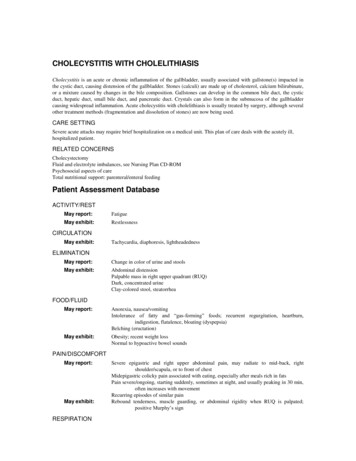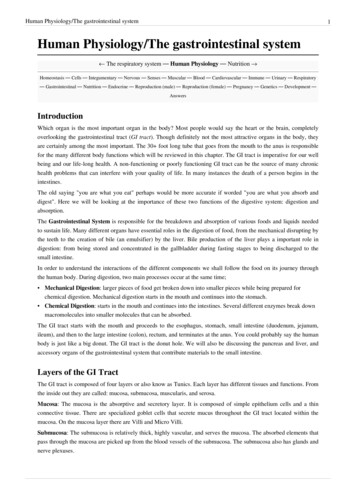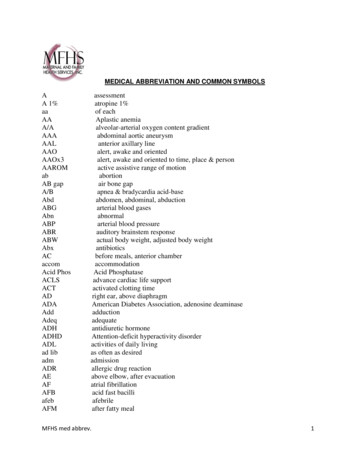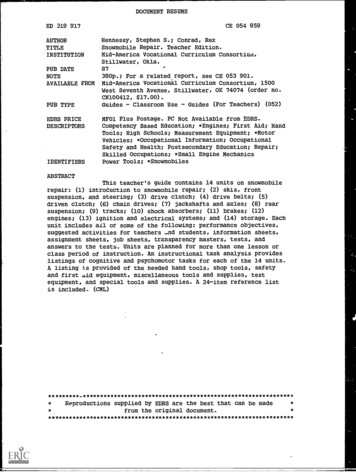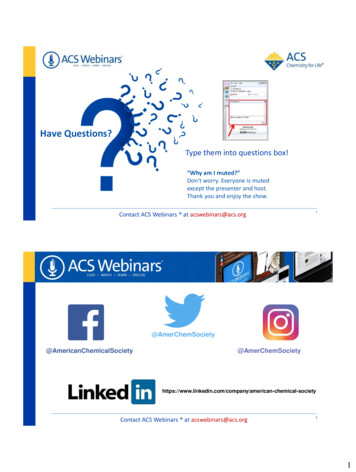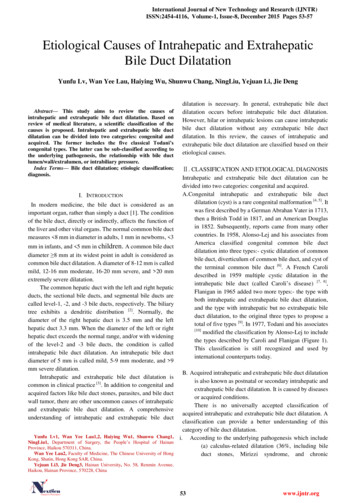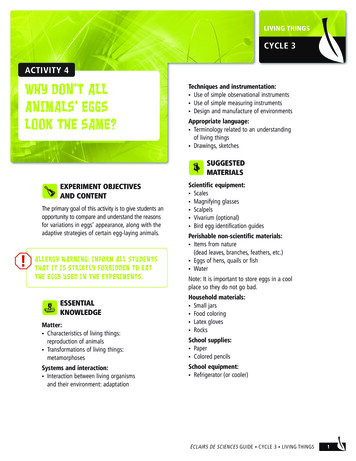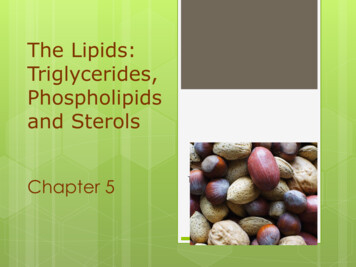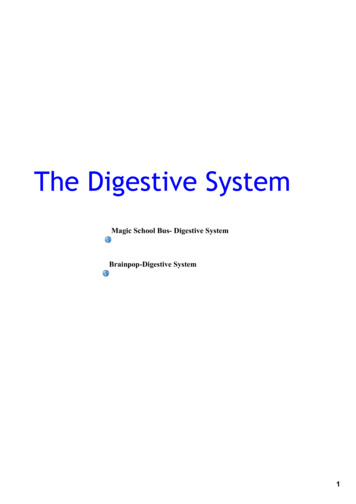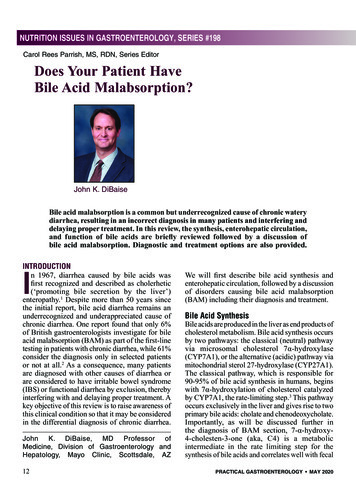
Transcription
NUTRITION ISSUES IN GASTROENTEROLOGY, SERIES #198Carol Rees Parrish, MS, RDN, Series EditorDoes Your Patient HaveBile Acid Malabsorption?John K. DiBaiseBile acid malabsorption is a common but underrecognized cause of chronic waterydiarrhea, resulting in an incorrect diagnosis in many patients and interfering anddelaying proper treatment. In this review, the synthesis, enterohepatic circulation,and function of bile acids are briefly reviewed followed by a discussion ofbile acid malabsorption. Diagnostic and treatment options are also provided.INTRODUCTIONn 1967, diarrhea caused by bile acids wasfirst recognized and described as cholerhetic(‘promoting bile secretion by the liver’)enteropathy.1 Despite more than 50 years sincethe initial report, bile acid diarrhea remains anunderrecognized and underappreciated cause ofchronic diarrhea. One report found that only 6%of British gastroenterologists investigate for bileacid malabsorption (BAM) as part of the first-linetesting in patients with chronic diarrhea, while 61%consider the diagnosis only in selected patientsor not at all.2 As a consequence, many patientsare diagnosed with other causes of diarrhea orare considered to have irritable bowel syndrome(IBS) or functional diarrhea by exclusion, therebyinterfering with and delaying proper treatment. Akey objective of this review is to raise awareness ofthis clinical condition so that it may be consideredin the differential diagnosis of chronic diarrhea.IJohn K. DiBaise, MD Professor ofMedicine, Division of Gastroenterology andHepatology, Mayo Clinic, Scottsdale, AZ12We will first describe bile acid synthesis andenterohepatic circulation, followed by a discussionof disorders causing bile acid malabsorption(BAM) including their diagnosis and treatment.Bile Acid SynthesisBile acids are produced in the liver as end products ofcholesterol metabolism. Bile acid synthesis occursby two pathways: the classical (neutral) pathwayvia microsomal cholesterol 7α-hydroxylase(CYP7A1), or the alternative (acidic) pathway viamitochondrial sterol 27-hydroxylase (CYP27A1).The classical pathway, which is responsible for90-95% of bile acid synthesis in humans, beginswith 7α-hydroxylation of cholesterol catalyzedby CYP7A1, the rate-limiting step.3 This pathwayoccurs exclusively in the liver and gives rise to twoprimary bile acids: cholate and chenodeoxycholate.Importantly, as will be discussed further inthe diagnosis of BAM section, 7-α-hydroxy4-cholesten-3-one (aka, C4) is a metabolicintermediate in the rate limiting step for thesynthesis of bile acids and correlates well with fecalPRACTICAL GASTROENTEROLOGY MAY 2020
Does Your Patient Have Bile Acid Malabsorption?NUTRITION ISSUES IN GASTROENTEROLOGY, SERIES #198bile acid loss. Newly synthesized bile acids areconjugated with glycine or taurine and secreted intothe biliary tree; in humans, most of the bile acidsare conjugated to glycine.4 Conjugation is a veryimportant step in bile acid synthesis convertingweak acids to strong acids, which are fullyionized at biliary and intestinal pH, and makingthem hydrophobic (lipid soluble) and membraneimpermeable. These properties aid in digestion oflipids and also decrease the passive diffusion of bileacids across cell membranes during their transitthrough the biliary tree and small intestine.5 Thisallows maximum lipid absorption throughout thesmall intestine without sacrificing bile acid loss.Enterohepatic CirculationAfter their involvement in micelle formation, about95% of the conjugated bile salts are reabsorbedin the terminal ileum and returned to the liver viathe portal venous system for eventual recirculationin a process known as enterohepatic circulation;only a small proportion (3-5%) are excreted intothe feces (Figure 1).6,7Enterohepatic circulation requires carriermediated transport.8 First, the bile acids areactively transported from the intestinal lumen intothe enterocyte via a network of efficient sodiumdependent apically located co-transporters (ilealbile acid transporters)6,7 in the distal ileum up to 100cm proximal to the ileocecal valve.9 The bile acidsare then transported into the portal venous systemvia a basolateral transport system consisting of 2proteins, organic solute transporter (OST)-α andOST-ß, and returned to the liver. In the liver, theyare efficiently extracted by basolateral transporterson the hepatocytes and added to the bile acid pool.The liver must then only replace the small amountof bile acids that are not recirculated and insteadexcreted into the feces (about 0.3-0.5 g/day). Inhumans, approximately 12 g of bile acids aresecreted into the intestine daily. Efficient recyclingallows the maintenance of a bile acid pool of about2-3 g, which typically cycles 4-6 times/day.10The size of the bile acid pool is tightlycontrolled by a complex regulatory pathway.Bile acid synthesis is under negative feedbackregulation by which bile acids downregulatetheir own biosynthesis by binding to the nuclearreceptor, farnesoid X receptor (FXR), therebyPRACTICAL GASTROENTEROLOGY MAY 2020 Figure 1. Enterohepatic circulation of bile acids.See text for details.BA, bile acid; CA, cholic acid; CDCA, chenodeoxycholicacid; DCA, deoxycholic acid; LCA, lithocholic acid;FGF, fibroblast growth fact 19; C4, 7-α-hydroxy-4cholesten-3-one.Reprinted from Vijayvargiya P and CamilleriM. Gastroenterology 2019;156:1233-1238 withpermission from Elsevier.inducing the synthesis of a repressor protein, whichdownregulates the rate-limiting enzyme in bile acidsynthesis, CYP7A1.11 Recently, fibroblast growthfactor 19 (FGF19), acting via FXR, was shown tobe stimulated by bile acids in the ileal enterocyte.12FGF19 is then released from the enterocyte andtravels to the liver where, acting together withß-klotho, it activates the FGF receptor 4 (FGFR4)on the hepatocyte leading to a phosphorylationcascade that downregulates bile acid synthesis(Figure 2).13A small proportion of the secreted bile acidsreach the colon where they are deconjugated(removing the taurine or glycine) anddehydroxylated (removing the 7-OH group) bybacteria to produce the secondary bile acids,deoxycholate and lithocholate. A small fractionof these secondary bile acids are absorbed by thecolonic epithelium; however, most are eliminatedin the feces.Bile Acid FunctionBile acids play a key role in the absorption oflipids in the small intestine. Upon stimulation bya meal (via cholecystokinin release), bile acids areexpelled from the gallbladder into the bile duct13
Does Your Patient Have Bile Acid Malabsorption?NUTRITION ISSUES IN GASTROENTEROLOGY, SERIES #198and then enter the lumen of the small intestinewhere they solubilize dietary lipids in a multistepprocess.14 First, they emulsify the lipids, dispersingthe droplets and increasing the surface area fordigestive enzymes. Next, they form micelles withthe products of lipid digestion, allowing the normallyhydrophobic lipids to dissolve into the aqueousluminal environment. The micelles then diffuseto the brush-border membrane of the intestinalepithelium whereby the lipids are released fromthe micelles and diffuse down their concentrationgradients into the cells. Once released, the bileacids are left behind in the intestinal lumen untilthey are absorbed in the terminal ileum. Of note,some degree of passive absorption of bile acidsoccurs throughout the length of the small bowel.The presence of bile acids in the intestinal lumenallows maximal absorption of lipids throughoutthe small intestine; however, the majority of fatabsorption occurs in the proximal 100 cm of thejejunum.Multiple other functions of bile acids have alsobeen described including: Contribute to cholesterol metabolism bypromoting the excretion of cholesterol.1 Denature dietary proteins, therebyaccelerating their breakdown by pancreaticproteases.15 Direct and indirect antimicrobial effects.16In this capacity, recent evidence suggests bileacids are mediators of high-fat diet-inducedchanges in the gut microbiota.17 Act as signaling molecules outside of thegastrointestinal tract.18Clinical Presentation and Role ofBile Acids in Bile Acid MalabsorptionNonbloody diarrhea is the hallmark symptom ofBAM. In an online survey of 100 patients withBAM out of 1300 members of a BAM supportgroup, 85% reported fecal urgency, 54% abdominalpain, 88% occasional fecal incontinence, and52% felt the need to be close to the bathroom.19Among those with abdominal discomfort, 40%reported fatigue and at least 60% ‘brain fog’, whichprevented work efficiency. After treatment withbile acid sequestrants, gastrointestinal and systemic14 Figure 2. Molecular mechanisms responsible for thecontrol of bile acid synthesis. See text for details.Reprinted from Rao AS et al. Chenodeoxycholate infemales with irritable bowel syndrome-constipation:a pharmacodynamic and pharmacogeneticanalysis. Gastroenterology 2010;139:1459-1558with permission from Elsevier.symptoms improved or resolved by at least 50%,and there was a significant improvement in workabsences and altered work hours.Excess bile acids entering the colon contributeto the classical symptoms associated with BAM.Bile acids stimulate secretion in the colon byactivating intracellular secretory mechanisms,increasing mucosal permeability, inhibitingCl– / OH– exchange and enhancing mucussecretion.20 Colonic water secretion depends onthe concentration of bile acids, with concentrationstypically 3 mmol/L leading to secretion.21 Bileacids also stimulate colonic motility by inducingpropulsive contractions thereby shortening colontransit time, potentially worsening urgency anddiarrhea.22,23 Interestingly, low concentrationsof bile acids downregulate colon secretion andpromote fluid and electrolyte absorption.24 Incontrast, when colonic luminal concentrationsof bile acids are high, as is seen in BAM, bileacids induce prosecretory and promotility effects,manifesting clinically as diarrhea.Prevalence of Bile Acid MalabsorptionDue to the limited availability of diagnostic testsfor BAM, its prevalence remains unclear. Theavailability of the 75Selenium-homocholic acidPRACTICAL GASTROENTEROLOGY MAY 2020
Does Your Patient Have Bile Acid Malabsorption?NUTRITION ISSUES IN GASTROENTEROLOGY, SERIES #198Table 1. Causes of Bile Acid MalabsorptionEtiologyConsider BAMof BAMif Symptomatic Terminal ileal resectionType 1or bypass Terminal ileal disease(e.g., Crohn’s disease)Type 2 No definitive etiology No demonstrativeileal diseaseType 3 Small intestinal bacterialovergrowth Postcholecystectomy Postvagotomy Celiac disease Radiation enteritis Chronic pancreatitistaurine (SeHCAT) retention test (see below) inEurope has, nevertheless, allowed an estimate ofits prevalence, at least in the Western world. Twosystematic reviews of studies that estimated theprevalence of primary bile acid diarrhea using theSeHCAT test in patients with chronic unexplaineddiarrhea and/or diarrhea-predominant irritablebowel syndrome (D-IBS)] suggest that, at thebest confidence interval ( 10%) for SeHCATretention percentage, 16.9% to 35.3% of patientshad an abnormal result suggesting BAM.25,26 Arecent prospective study analyzed data from 118consecutive patients meeting Rome III criteria forD-IBS who underwent SeHCAT testing. Twentyeight (24%) were found to have BAM (8 mild, 8moderate and 12 severe).27It is estimated that 5% of the population indeveloped countries has chronic diarrhea at anypoint in time, incurring direct and indirect costsof about 660 million per year.28 Given the 25%30% prevalence of BAM in patients with chronicdiarrhea, the prevalence in the general populationwould be about 1%.Types of Bile Acid MalabsorptionIn a retrospective analysis of 373 patientsundergoing SeHCAT testing, 190 were found tohave BAM. Multivariate analysis showed thatprior cholecystectomy, terminal ileal resection orPRACTICAL GASTROENTEROLOGY MAY 2020 right hemicolectomy for Crohn’s disease or otherreasons were associated with BAM.29 Nearly 65%of those with BAM had either no risk factors forBAM or met criteria for D-IBS.The cause of BAM may be divided into threemain types (Table 1).30:Type 1 BAM results from terminal ilealresection/bypass or disease (e.g., Crohn’s disease),which results in failure of enterohepatic recyclingof bile acids, and excess amounts entering thecolon. Resection of less than 100 cm of terminalileum will interrupt the normal feedback, resultingin increased bile acid synthesis and an increasedconcentration of unabsorbed bile acids entering thecolon.31 When more than 100 cm of distal ileumin adults is resected, the resulting reduction inbile acid absorption exceeds the liver’s ability tosynthesize adequate replacement. This ultimatelyresults in a decreased bile acid pool with impairedmicelle formation and fat digestion, and manifestsclinically as steatorrhea and fat soluble vitamindeficiencies. Maximum bile acid synthesis (5-10mmol/day) is less than daily bile acid secretion inhealthy patients (about 25-30 mmol/day).32Type 2 BAM, often referred to as primary bileacid diarrhea (PBAD), is the most common causeof bile acid malabsorption and may account for atleast 30% of individuals who would otherwise belabeled as having D-IBS or functional diarrhea.Importantly, the current definition of PBADrequires that there be a grossly and histologicallynormal ileum and good response to treatment witha bile acid sequestrant. Despite much investigation,until recently the pathogenesis of PBAD has beenpoorly understood. Recently, a role of alteredfeedback inhibition of bile acid synthesis hasbeen proposed.33 This altered feedback regulationis thought to be mediated by FGF19 (fibroblastgrowth factor 19).34-36 Walters and colleagues foundthat patients with PBAD had a marked decreasein plasma levels of FGF19, about 50% that ofcontrols, and this level correlated inversely withbile acid synthesis as measured by the serum levelof C4.37 As a consequence of this deficiency, thehepatocytes are unable to downregulate bile acidsynthesis. It was speculated that this disruptedfeedback control by FGF19 may result in a largebile acid pool with incomplete ileal absorption andincreased bile acid delivery to the colon causing15
Does Your Patient Have Bile Acid Malabsorption?NUTRITION ISSUES IN GASTROENTEROLOGY, SERIES #198Table 2. Principal Diagnostic Tests for Bile Acid MalabsorptionTestAdvantagesDisadvantages75 Radiation exposureSeHCAT Well-defined diagnostic cutoffs Not widely available Level of retention predictsresponse to bile acid bindersFecal Bile Acids Gold standard Measures total and individualbile acids Direct measure Variable daily bile acid excretionRequires 48-hr sampleRequires 96-hr 100 g/d fat dietUnknown response to bile acid bindersRequires sophisticated testing methodsNot widely availableC4 Blood test Single visit No diet limitations Requires fasting sampleSuboptimal specificityDiagnostic accuracy still uncertainUnknown response to bile acid bindersRequires sophisticated testing methodsdiarrhea. The exact nature of the defect that leadsto altered FGF19 production or release requiresfurther investigation.Type 3 BAM includes causes of BAM notincluded with types 1 and 2 that may interfere withnormal bile acid cycling, small intestinal motility,or composition of ileal contents (Table 1).Diagnosis of Bile Acid MalabsorptionThere are 3 main types of diagnostic tests for BAM(Table 2): the direct measurement of fecal bileacids, the measurement of serum biomarkers ofbile acid synthesis, and the evaluation of terminalileal reabsorption of bile acids with the SeHCATretention test. Another test of BAM that has fallenfrom favor and is more of historical interest isthe 14 C-glycocholate breath test.38 All of thesetests have limitations that to date have hinderedthe recognition of BAM in patients with chronicdiarrhea.The measurement of total and individualfecal bile acids is a direct measure of excess bileacids exiting the colon. The diagnosis of BAMby measurement of fecal bile acids in a 48-hourstool collection while on a 100 g/d fat diet for 2days prior to starting and during the collection,the definitive method, is unpleasant and requireshigh performance liquid chromatography (HPLC)with mass spectrometry (MS) and, as such, until16 recently was available only in research laboratories.Unlike with the SeHCAT test, there are currently norandomized clinical trials that have evaluated theresponse of bile acid binders to those with elevatedfecal bile acids. There are ongoing investigationsinto whether measurement of bile acids in a single,random stool sample may be able to replace theneed for a 48-hour stool collection.In the SeHCAT test, first described in 1981, theselenium-labeled bile acid is administered orallyand the total body retention is measured with agamma camera after 7 days.39 Diagnostic cut-offsand response to bile acid sequestrant therapy are asfollows: 5% (severe) with 96% response, 10%(moderate) with 80% response, and 15% (mild)with 70% response.25 This test has a sensitivity fordiagnosing BAM of 80-90% and a specificity of70-100%, and offers a low radiation dose to thepatient.40 While the SeHCAT test is currently theclinical gold standard, it has never been approvedfor use in the United States and is not widelyavailable in the rest of the world.More recently, the measurement of serumbiomarkers of bile acid synthesis has been proposedas a potential test of BAM.41 Serum 7-α-hydroxy-4cholesten-3-one (C4) is a direct measure of bile acidsynthesis, and C4 levels are substantially elevatedin BAM patients with a sensitivity and specificityof 90% and 77%, respectively for type 1 BAM (seePRACTICAL GASTROENTEROLOGY MAY 2020
Does Your Patient Have Bile Acid Malabsorption?NUTRITION ISSUES IN GASTROENTEROLOGY, SERIES #198Table 3. Commercially-available Bile Acid SequestrantsDrugDosageSide EffectsNausea, vomiting, flatulence,Cholestyramine 4-gram packet,1 to 6 times/daybloating, abdominal discomfort,(Questran , constipation, fecal impaction,Questran Light,anorexia, steatorrhea, urticariaPrevalite ,LoCHOLEST ,LoCHOLEST Light)CommentsPoor taste may affectadherenceMay interfere with theabsorption of somemedications (warfarin,diuretics, thyroid hormone,beta-blockers, digoxin)and fat-soluble vitamins– medications should betaken 1-hour before or atleast 4-hours after bile acidsequestrant administrationColestipol(Colestid )5-gram packet,1 to 6 times/dayTablet formalso availableSame as aboveColesevelam(WelChol )1.25 to 3.75 g/dayConstipation, dyspepsia,Does not decreasenausea, nasopharyngitis,the absorption of coheadache, asthenia, influenzaadministered medicationstype symptoms, rhinitis,hypoglycemia in diabeticpatients, myalgias, hypertensionbelow) and 97% and 74%, respectively for type2 BAM (see below).42,43 Furthermore, C4 levelshave been shown to correlate well with SeHCATretention.44 Despite its obvious advantages in thediagnosis of BAM, this test also requires HPLCMS.45 and, until recently, was available for researchuse only. Alternatively, FGF19 represents anindirect measure of bile acid reabsorption as itprovides feedback inhibition on hepatic bile acidsynthesis. FGF19 is measured by enzyme-linkedimmunosorbent assay. Sensitivity and specificityof FGF19 are lower than with C4.43 Both C4and FGF19 have diurnal variations necessitatingfasting samples. Ultimately, while convenient,these fasting biomarkers lack sufficient diagnosticaccuracy on their own and while the C4 test maybe considered as a screening tool, the FGF19 testcannot. Recently, a report described the use ofchenodeoxycholate-stimulated FGF19 responseas a provocative test of BAM.46 Further study isneeded before this test can be accepted into clinicalpractice.PRACTICAL GASTROENTEROLOGY MAY 2020 Same as aboveGiven the limited diagnostic testing for BAMcurrently available, particularly in the United States,a “therapeutic trial” with a bile acid sequestrant(see below) is often used as a diagnostic tool. If thetreatment results in resolution or improvement ofthe diarrhea, the response is considered supportiveevidence of BAM. This approach is supported bythe pooled data from a report showing a doseresponse relationship according to severityof malabsorption, as determined by SeHCATretention, to treatment with a bile acid sequestrant.24Although this approach has the advantage of notrequiring specialized investigations, as treatmentis often poorly tolerated and response variable, thisstrategy is difficult to strongly advocate withouta definitive diagnosis. Importantly, in the recentCanadian Association of Gastroenterology clinicalpractice guideline on the management of bile aciddiarrhea, testing rather than a therapeutic trial withbile acid binder, using SeHCAT (where available)or fasting plasma C4, was recommended.47(continued on page 24)17
Does Your Patient Have Bile Acid Malabsorption?NUTRITION ISSUES IN GASTROENTEROLOGY, SERIES #198(continued from page 17)Treatment of Bile Acid MalabsorptionTreatment of patients with bile acid diarrheasecondary to another cause (e.g., active Crohn’sileitis, microscopic colitis, small intestinal bacterialovergrowth) should target the underlying disease.Unfortunately, for most patients with BAM, nosuch cause is found or is effectively treatable.Therefore, for over 50 years, the treatment ofBAM has relied on the use of oral administrationof bile acid sequestrants.41 These agents arepositively charged indigestible resins that bindthe bile acids in the intestine to form an insolublecomplex that is excreted in the stool preventingtheir secretomotor actions on the colon. There arecurrently three bile acid sequestrants commerciallyavailable, albeit for a non-United States Food andDrug Administration (FDA)-labeled indication(i.e., off label use): cholestyramine, colestipol,and colesevelam (Table 3). Dietary intervention(i.e., low fat diet with or without medium chaintriglyceride supplementation) and aluminumhydroxide may also have a role; however, dataregarding their use is limited.48Cholestyramine and colestipol are FDAapproved for the treatment of hypercholesterolemia(both agents) and pruritus related to partialbiliary obstruction (cholestyramine only). In onereport, most patients with abnormal SeHCATretention were found to respond to treatmentwith cholestyramine in a dose-response manner:96% response in patients with SeHCAT retention 5%, 80% response when 10% retention, and70% response when 15% retention.24 However,as a powdered resin, their use has historically beenlimited by their unpleasant taste, which can lead topoor adherence with long-term use.49 Indeed, 40%to 70% of patients given bile acid sequestrantsdiscontinue them.50,51 A recent systematic review onthe management of chronic diarrhea related to BAMidentified 30 relevant publications (1241 patients)and found that cholestyramine was the most studiedtreatment, and was successful in 70% (of 801)patients.49 In a retrospective survey of 377 patientsdiagnosed with BAM by SeHCAT, at follow-up,50% of the patients reported improvement inthe diarrhea; however, 74% reported continueddiarrhea and 62% regularly used anti-diarrhealmedications.52 Sixty-four percent considered theirquality of life to be reduced because of the diarrheawhile 50% reported that the diarrhea was unalteredor worse than before the diagnosis of BAM wasestablished. Thus, it is clear that many patientswith BAM continue to have bothersome diarrheadespite proper diagnosis and treatment.Gastrointestinal side effects are common withcholestyramine and colestipol and include nausea,borborygmi, flatulence, bloating, and abdominaldiscomfort.53 Constipation may also occur, makingtitration of the dose important. For cholestyramine,the most commonly used bile acid sequestrant,starting with one 4 gram packet a day (5 gramsfor colestipol) and titrating upward as needed(maximum 6 times/day for both agents) seems tobe an effective strategy. Colestipol also comes intablet form; a form worth considering if the powderform is poorly tolerated. Other tips for improvingthe palatability of bile acid sequestrants arementioned in Table 4. Importantly, cholestyramineand colestipol interfere with the absorption of somemedications (e.g., warfarin, diuretics, thyroidhormone, beta-blockers, digoxin) and fat-solublevitamins. Therefore, these other medications shouldbe taken 1-hour before or at least 4-hours after bileacid sequestrant administration.Colesevelam is a newer bile acid sequestrantthat binds bile acids with a higher affinity thaneither cholestyramine or colestipol. It is availableTable 4. Tips to Making Bile Acid Sequestrants More Palatable Add powder to a half cup of applesauce or crushed pineapples and mix thoroughly. Add powder to a half cup of fruit drink, juice, or other non-caffeinated drink and mix thoroughly. Add powder to a half cup of milk or broth. Refrigerate the mixture. Stir well. Mix with half water to dissolve it first, then finish it off with a thick consistency juice/nectar or smoothie. Try mixing with pudding or custard.24 PRACTICAL GASTROENTEROLOGY MAY 2020
Does Your Patient Have Bile Acid Malabsorption?NUTRITION ISSUES IN GASTROENTEROLOGY, SERIES #198in tablet form, improving its patient acceptability.40Colesevelam is FDA-approved to treathypercholesterolemia and as an adjunct treatmentfor type 2 diabetes mellitus. In a retrospective chartreview and patient questionnaire, colesevelam atdoses between 1.25 and 3.75 g/day was found to bewell tolerated and effective in many cancer patientswho developed BAM, including some who hadfailed prior cholestyramine therapy.54 Colesevelamwas also found to be more effective than placeboin a small, randomized controlled trial in patientswith D-IBS with regards to symptom control andcolon transit.55 Furthermore, single nucleotidepolymorphisms of FGFR4 and ß-klotho have beenfound that appear to identify a subset of D-IBSpatients who may benefit from colesevelam.56Colesevelam does not decrease the absorption ofco-administered medications,53 presumably becauseof differences in chemical structure compared tocholestyramine and colestipol.A proof-of-concept open-label study indicatedthat obeticholic acid produces clinical benefit,increases FGF19 and reduces C4 in patientswith primary and secondary forms of BAM.57Obeticholic acid, which is approved for thetreatment of primary biliary cholangitis, stimulatesthe FXR of the terminal ileum, thereby increasingFGF19, which provides feedback inhibition onhepatic bile acid synthesis. Recently, a case reporthas suggested a possible benefit from the use ofliraglutide58 in BAM unresponsive to bile acidbinders. Liraglutide, which is approved for thetreatment of type 2 diabetes mellitus and obesity,also slows gastrointestinal transit. It is thismechanism that is speculated liraglutide exerts itseffect on BAM by increasing passive absorptionof bile acids throughout the small bowel andallowing enhanced active bile acid absorption inthe terminal ileum. This may also lead to increasedFXR activation and FGF19 secretion, which, inturn, will decrease hepatic bile acid synthesis.Practice GuidelinesThe Canadian Association of Gastroenterologyrecently published a clinical practice guideline onthe management of BAM.47 A systematic reviewwas conducted and the quality of the evidence andstrength of recommendations were rated accordingto the Grading of Recommendation Assessment,PRACTICAL GASTROENTEROLOGY MAY 2020 Development and Evaluation (GRADE) approach.The quality of the evidence was generally rated asvery low; as such, most of the recommendationsare conditional. In patients with chronic diarrhea,consideration of risk factors (e.g., terminalileal resection, cholecystectomy or abdominalradiotherapy), but not additional symptoms, wasrecommended for identification of patients withpossible BAM. Testing, rather than a therapeutictrial with bile acid binder, using SeHCAT (whereavailable) or fasting plasma C4, including patientswith D-IBS, functional diarrhea and Crohn’sdisease without inflammation was recommended.Cholestyramine was suggested as initial therapy aswas use of antidiarrheal agents if bile acid binderswere not tolerated.CONCLUSIONBy recognizing that BAM is a relatively commoncause of chronic diarrhea, it should followthat physicians will more readily recognize,evaluate, and treat patients with this condition.We recognize that given the limitations in theavailability of diagnostic testing and difficulties incompleting an adequate empiric trial of a bile acidsequestrant, BAM is likely to remain a problematicdiagnosis, at least for the near future. The recentdevelopment and validation of a 48-hr fecal bileacid measurement and the convenient blood-basedmeasurement of C4, will, hopefully, change thisclinical practice. Treatment of BAM remainsusing bile acid sequestrants; the availability ofcolesevelam has improved patient tolerabilityto this form of therapy. Perhaps a more specifictherapy, such as a FGF19 or FXR agonist, willbecome available for clinical use in the future.References1. Hofmann AF. The syndrome of ileal disease and the broken enterohepaticcirculation: cholerhetic enteropathy. Gastroenterology.1967;52:752-757.2. Khalid U, Lalji A, Stafferton R, et al. Bile acid malabsorption: a forgotten diagnosis? Clin Med. 2010;10:124-126.3. Russell DW. The enzymes, regulation, and genetics of bile acid synthesis. Ann Rev Biochem. 2003;72:137–174.4. Dawson P, Benjamin S, Hofmann A. Bile formation and the enterohepatic circulation. In Johnson L (ed.) Physiology of the GastrointestinalTract, 4th ed. Elsevier. 2006;4:1437–1462.5. Kamp F, Hamilton JA, Kamp F, et al. Movement of fatty acids, fattyacid analogues, and bile acids across phospholipid bilayers. Biochem.1993;32:11074–11086.6. Wong MH, Oelkers P, Craddock AL, et al. Expression cloning and characterization of the hamster ileal sodium-dependent bile acid transporter.J Biol Chem. 1991;269:1340–1347.7. Shneider BL, Dawson PA, Christie DM, et al. Cloning and molecu
Hepatology, Mayo Clinic, Scottsdale, AZ We will first describe bile acid synthesis and enterohepatic circulation, followed by a discussion of disorders causing bile acid malabsorption (BAM) including their diagnosis and treatment. Bile Acid Synthesis Bile acids are produce
